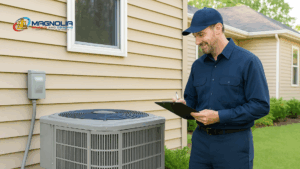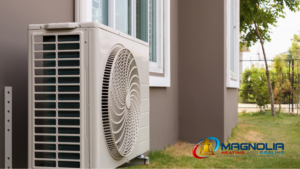
Navigating the world of air conditioning can be a complex endeavor, especially when it comes to understanding efficiency ratings. A crucial aspect of this journey is the SEER rating, a measure of an air conditioner’s efficiency. The HVAC pros at Magnolia Heating and Cooling understand what goes into good SEER ratings, why they matter, and how to achieve the best SEER rating for your air conditioning needs.
Understanding SEER Ratings
SEER stands for Seasonal Energy Efficiency Ratio. This rating indicates how much cooling an air conditioner delivers for each unit of energy it consumes. Essentially, a higher SEER rating means greater energy efficiency. The calculation is made by dividing the cooling output over a typical cooling season by the total electric energy input during the same period.
The Evolution of SEER Standards
Over the years, SEER rating standards have evolved significantly. Earlier models of air conditioners had SEER ratings as low as 6 or 7, whereas modern air conditioners are required by law to have a minimum rating of 13 or 14, depending on the region. These changes reflect advancements in technology and a growing emphasis on energy conservation.
What Constitutes a Good SEER Rating?
A good SEER rating can vary depending on your specific needs and location. Generally, a rating between 13 and 16 is considered efficient and cost-effective for most residential homes. However, for those seeking higher energy savings and are willing to invest in advanced technology, air conditioners with ratings of 20 or above offer superior efficiency.

4 Factors to Consider When Choosing a SEER Rating
1) Climate: In regions with hot and long summers, like the Southern United States, an air conditioner with a higher SEER rating is more beneficial. These units operate more efficiently under heavy use, leading to significant energy savings during prolonged periods of hot weather. In contrast, in areas with milder summers, a moderately high SEER rating might be sufficient, as the air conditioner isn’t used as intensively.
2) Usage: For households where the air conditioner runs frequently or for extended periods, a unit with a higher SEER rating is more cost-effective. This is particularly true in commercial settings or large homes where the demand for cooling is high. Investing in a high-SEER unit in these scenarios can lead to substantial savings in operational costs over the lifespan of the air conditioner.
3) Home Insulation: The efficiency of an air conditioner is also impacted by the home’s insulation. Well-insulated homes retain cool air better, reducing the workload on the air conditioner. In such homes, even an air conditioner with a moderate SEER rating can perform efficiently, leading to energy savings. Conversely, in poorly insulated homes, a higher SEER rating might be necessary to compensate for the loss of cool air and ensure efficient cooling.
4) Budget: The upfront cost of air conditioners with higher SEER ratings is typically higher than those with lower ratings. However, it’s important to consider long-term savings through reduced energy bills. For budget-conscious consumers, a balance between the initial investment and expected energy savings is crucial. Financing options and potential rebates for high-efficiency units can also make them more accessible.
The Benefits of a High SEER Rating
1) Reduced Energy Bills: One of the most immediate and tangible benefits of a high SEER rating is the reduction in energy bills. Air conditioners with higher SEER ratings use less energy to provide the same amount of cooling as units with lower ratings. This increased efficiency translates directly into savings on your monthly utility bills. For instance, upgrading from an older model with a SEER rating of 8 or 10 to a modern unit with a rating of 20 or above can halve your air conditioning energy costs. This benefit is especially significant in areas with hot climates or for households where the air conditioner is used extensively.
2) Environmental Impact: High SEER air conditioners contribute positively to environmental conservation efforts. By consuming less energy, these units reduce the demand on power plants, which often rely on fossil fuels. This reduction in energy usage directly translates to lower carbon emissions, a critical factor in combating climate change. For environmentally conscious consumers, this aspect of high SEER units is a compelling reason to invest in them. Additionally, some high-efficiency air conditioners use refrigerants that are less harmful to the ozone layer, further mitigating their environmental impact.
3) Enhanced Comfort: Modern high-efficiency air conditioners often come with advanced features that not only improve their efficiency but also enhance the overall comfort level. These features may include variable speed compressors and fans, which allow the unit to adjust cooling output more precisely to maintain consistent temperatures. This results in fewer temperature fluctuations and a more consistent indoor environment. Moreover, these units tend to operate more quietly, contributing to a more pleasant and less intrusive experience, especially important in residential settings.
4) Long-Term Cost Savings: While high SEER air conditioners have a higher initial purchase price, their long-term cost savings can be substantial. Over the lifespan of the unit, the savings in energy costs can offset and often exceed the initial investment. This long-term financial benefit is an important consideration for homeowners planning to stay in their homes for many years. In addition to energy savings, high-efficiency units often have longer lifespans and may require less maintenance, further contributing to cost savings over time.
5) Increased Property Value: Homes equipped with high-efficiency air conditioning systems can see an increase in property value. Energy-efficient homes are increasingly sought after in the real estate market, as buyers are aware of the long-term savings and environmental benefits these systems offer. Installing a high SEER air conditioner can be a selling point, making the property more attractive to potential buyers and potentially increasing its resale value.
6) Rebates and Incentives: To encourage the adoption of energy-efficient appliances, many governments and utility companies offer rebates and incentives for high SEER air conditioners. These programs can significantly reduce the initial cost of purchasing a high-efficiency unit, making them more accessible to a wider range of consumers. By taking advantage of these incentives, homeowners can further reduce the overall cost of upgrading to a more efficient air conditioning system.
Get the Best HVAC Service Around with Magnolia Heating and Cooling
Selecting the right air conditioner with an appropriate SEER rating requires considering various factors, including climate, usage patterns, home insulation, and budget constraints. Understanding these aspects ensures that you make an informed decision, balancing upfront costs with long-term benefits. Our team of local A/C professionals is dedicated to helping you navigate these choices. For personalized advice and high-quality HVAC solutions, contact Magnolia Heating and Cooling for expert guidance and exceptional service!



